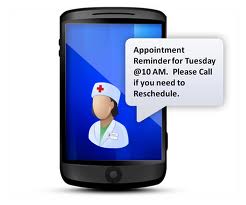
Reducing healthcare costs can be spurred by using popular forms of communication including mobile, email, and much more. There are times when missing your doctor appointment can’t be helped — bad weather, work-related issues or possibly a sick child. Others miss appointments for more avoidable reasons such as forgetfulness or scheduling errors on their or the medical staff’s part. No matter the reason, these missed appointments are adding up, and it’s costing doctors and patients a great deal of money and lost time.
Reducing Healthcare Costs with Increased Communication
When a patient fails to show up for office visits, there’s rarely sufficient time to fill in that appointment slot unless someone has just walked through the door. If there are nine or ten missed appointments every week for fifty weeks, it will add up to 500 unused office (or telehealth) visits, according to data from WebMD. Because some physicians are on salary, they don’t see an immediate economic impact, but their employer notices it when they multiply that number by several hundred medical providers. WebMD also showed that low-income patients, or those on Medicaid, tend to miss the most appointments, and many doctors are starting to charge patients when they fail to show. Some doctors assess a no-show fee upwards of $600 or more, making it difficult for those of lower socioeconomic standing to pay for their absences.
Through our research at TeleVox, we’ve found that high-tech engagement communications, such as email, text, and voicemail, can provide an ongoing connection for patients on a daily basis. It’s not enough to prescribe a treatment plan and advise a “follow-up.” Healthcare professionals must activate patients to make positive behavior changes for a healthy life. Activation requires ongoing alerts to take medication, eat right, exercise and reminders for when to schedule a follow-up or prompt them of their existing appointment. One of our recent Healthy World Reports showed that 83 percent of people across the nation admit they don’t follow treatment plans exactly as prescribed. When we asked patients how they felt about office visits in a virtual setting, an astounding 85 percent responded that communications such as email, text messages and voicemails are as helpful, if not even more helpful, than in-person or phone conversations with their healthcare provider in terms of helping them stay on track with doctor-recommended behaviors between visits.
such as email, text, and voicemail, can provide an ongoing connection for patients on a daily basis. It’s not enough to prescribe a treatment plan and advise a “follow-up.” Healthcare professionals must activate patients to make positive behavior changes for a healthy life. Activation requires ongoing alerts to take medication, eat right, exercise and reminders for when to schedule a follow-up or prompt them of their existing appointment. One of our recent Healthy World Reports showed that 83 percent of people across the nation admit they don’t follow treatment plans exactly as prescribed. When we asked patients how they felt about office visits in a virtual setting, an astounding 85 percent responded that communications such as email, text messages and voicemails are as helpful, if not even more helpful, than in-person or phone conversations with their healthcare provider in terms of helping them stay on track with doctor-recommended behaviors between visits.

The current, major push towards prevention happening in the U.S. will also serve to save time and money for both patients and doctors. With prevention, doctors aim to improve and sustain the health and well-being of patients, while reducing healthcare costs, allowing funds to be directed to research and other patients with unpreventable needs. Our studies showed that 95 percent of Americans feel preventive care is important, yet only 24 percent give themselves an A grade for their efforts to ensure a preventive-friendly lifestyle. In the past two years, less than half of the adults we surveyed said they’ve exercised routinely, and only 52 percent said that they’ve attempted to improve their eating habits or have incorporated more nutritious foods into meals.
These preventive actions hold extreme importance as, according to a recent CDC report, over one-third of U.S. adults (35.7 percent) are obese. Yet, we found that few adults in the U.S. are receiving preventive screenings for most conditions that are directly related to obesity. In the past two years, only 26 percent of adults in the U.S. have been screened for diabetes, only 33 percent have had their cholesterol checked, and a measly 15 percent have been screened for cancer. These patients are not being engaged on a consistent basis to elicit action and responsibility for their health, which is what ultimately can lead to an overall lifestyle change. When a patient feels accountable for the success of their wellness, they’re more likely to show up for scheduled appointments and follow their treatment plans for the purpose of becoming or remaining healthy. With high-tech communication, doctors can help foster this accountability by communicating the importance of healthy habits and keeping patients motivated toward wellness, saving money, time, and lives.
Scott Zimmerman is a regularly published thought leader on engaging patients via ongoing communication between office visits. He is the President of TeleVox Software, Inc., a high-tech Engagement Communications company that provides automated voice, email, SMS, and web solutions that activate positive patient behaviors by applying technology to deliver a human touch. Scott spearheads TeleVox’s Healthy World initiative, a program that leverages ethnographic research to uncover, understand and interpret both patient and provider points of view with the end goal of creating a healthy world–one person at a time. Zimmerman possesses 20 years of proven performance in the healthcare industry, with domain knowledge in the surgical, interventional and pharmaceutical arenas. Prior to joining TeleVox, Scott served for nine years at GE Healthcare in a variety of cross-functional and global leadership roles in sales, services, quality, marketing, pricing, finance and product development. Scott is a graduate of the John M. Olin School of Business at Washington University in St. Louis.
President of TeleVox Software, Inc., a high-tech Engagement Communications company that provides automated voice, email, SMS, and web solutions that activate positive patient behaviors by applying technology to deliver a human touch. Scott spearheads TeleVox’s Healthy World initiative, a program that leverages ethnographic research to uncover, understand and interpret both patient and provider points of view with the end goal of creating a healthy world–one person at a time. Zimmerman possesses 20 years of proven performance in the healthcare industry, with domain knowledge in the surgical, interventional and pharmaceutical arenas. Prior to joining TeleVox, Scott served for nine years at GE Healthcare in a variety of cross-functional and global leadership roles in sales, services, quality, marketing, pricing, finance and product development. Scott is a graduate of the John M. Olin School of Business at Washington University in St. Louis.
